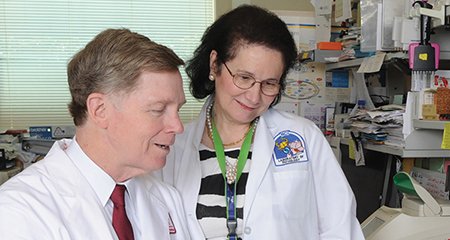September 2018—Leo Tolstoy is not listed as a coauthor on the most recent iteration of The Cancer Genome Atlas on renal cell carcinoma, which focuses on molecular characterization of RCC.
Read More »September 2018
Hemophilia drug interferes with APTT-based assays
September 2018—When a miracle drug comes along that is predicted to cause havoc in the laboratory, the drug could well seem like a double-edged sword. In the case of emicizumab (Genentech’s Hemlibra), for patients with hemophilia A, the mix of both benefits and drawbacks is likely to settle in for the long term.
Read More »Forward march on commercial NAAT for M. genitalium
September 2018—About five years ago, when William M. Geisler, MD, MPH, was still focusing his research at the University of Alabama at Birmingham on chlamydia, Mycoplasma genitalium carried a lower profile as a cause of sexually transmitted infection.
Read More »For autopsy service, new requirements in AP checklist plus nine new requirements for forensic autopsies
September 2018—Quality management, communication, and consent are among the issues addressed in new and revised requirements in the autopsy pathology section of the latest edition of the CAP accreditation program anatomic pathology checklist.
Read More »From the President’s Desk: Policies to protect and preserve
September 2018—CAP leadership presents a gamut of responsibilities, including the enforcement of policies adopted to protect members and staff. What I am about to discuss is relevant to all organizations and work settings. As you read on, I hope you will reflect on how tolerance for inappropriate behavior could have an impact on your own workplace and what steps you can take to protect yourself, your colleagues, and by extension your patients.
Read More »Urine drug testing debate: How best to test compliance and manage opioid crisis
September 2018—Qualitative or quantitative testing. Hydrolyze or don’t hydrolyze. Use or don’t use standard cutoffs. These and other decisions in toxicology testing have taken on new urgency amid the opioid crisis, which is driving laboratories to change test methods to assess prescription drug compliance and illicit drug use.
Read More »‘We wanted to be the best we could possibly be’: CAP ISO 15189-accredited labs on the difference it makes
September 2018—Ten years ago, Richard J. Zarbo, MD, was feeling pretty proud of his laboratory. As system chairman of pathology and laboratory medicine at Detroit-based Henry Ford Health System, over the previous few years he’d seen his team rigorously implement Lean practices, practices that had paid off in greater safety and efficiency. “Setting the bar higher was important because that’s the culture here,” he says. “This is what we do.”
Read More »Next step? The switch from stool culture to PCR
September 2018—The advantages of moving from stool culture to a molecular platform are many: faster time to results, more accurate pathogen identification, a savings of space and staff time. For Jose Alexander, MD, D(ABMM), SM, MB(ASCP), and colleagues at Florida Hospital Orlando, another plus is being able to adhere to the Infectious Diseases Society of America guideline suggestion that labs use a diagnostic approach that can distinguish O157 from non-O157 E. coli and Shiga toxin 1 from Shiga toxin 2 E. coli.
Read More »Xifin CEO: Time to tune up negotiations with payers
September 2018—The second round of PAMA data collection is coming in 2019 and it’s critical to get it right, said Lâle White, CEO of Xifin, in a presentation in May at the Executive War College. If it’s not right, she warned, laboratories could see cuts that are more severe than those already seen.
Read More »Put It on the Board
Broad-based molecular testing for NSCLC September 2018—A recently published study on broad-based genomic sequencing and survival among patients with advanced non-small cell lung cancer in the community oncology setting should not lead to the conclusion that such sequencing should be avoided in nonsquamous NSCLC, say Paul A. Bunn Jr., MD, and Dara L. Aisner, MD, PhD, of the University of Colorado Denver, Aurora. Dr. Bunn, of the Department of Medical Oncology, and Dr. Aisner, of the Department of Pathology, in an editorial published Aug. 7 in JAMA, caution readers about the study published in the same issue, which found that broad-based sequencing (more than 30 cancer genes) directly informed treatment in a minority of patients and was not independently associated with better survival. The study of 5,688 patients with advanced NSCLC was based on data acquired through abstraction and aggregation of information from the electronic medical record from 191 U.S. community oncology practices.
Read More »Q&A column
Q. Is there expert advice or standard practice for releasing preliminary critical values for patients to the LIS pending subsequent technologist or technician verification and documentation? Read answer. Q. We hope to validate a procedure for the fixation, decalcification, and staining of bone marrow specimens but we will not be able to access fresh marrow specimens for our decalcification validation. Can you recommend an alternative tissue to validate the preservation of tissue morphology and antigenicity after decalcification? Read answer.
Read More »Clinical pathology selected abstracts
Outcomes of an audit of repeat lab testing at an academic medical center
September 2018—Overutilization of laboratory tests increases health care costs and may lead to false-positive test results and ambiguous findings. Unnecessary testing can result from a single order from a provider, an automated function in an order set, or a combination of the two.
Anatomic pathology selected abstracts
Thymoma: a clinicopathological correlation of surgical resection cases
September 2018—The authors presented 1,470 surgical resections for thymoma from the pathology files of 14 institutions in 11 countries with the purpose of determining and correlating a simplified histological classification of thymoma and pathological staging with clinical outcome.
Molecular pathology selected abstracts
Ability of genetic alterations to predict development of acute myeloid leukemia
September 2018—Acute myeloid leukemia affects more than 60,000 people in the United States every year and has a mortality rate of more than 90 percent. It is the most common form of acute leukemia and is caused by unchecked growth of immature precursor cells in the bone marrow. These immature cells, or blasts, are myeloid precursors that often develop into dysfunctional, cancerous white blood cells that fill the bone marrow and spread into the blood.
Newsbytes
Nebraska informaticians mine and translate genomic data
September 2018—More than five years have elapsed since clinicians at the University of Nebraska Medical Center approached the institution’s informatics department with a problem. They wanted to more easily access structured genomic data stored in the EHR system for the diagnosis of cancer patients.
Letters
Burnout
September 2018—As a pre-med student, I am shadowing a pathologist mentor at a major cancer hospital to gain insight into the life of physicians. She introduced me to CAP TODAY. I write in response to “Frontline dispatches from the burnout battle,” by Karen Titus (June 2018), to share the thoughts of a novice who now knows that becoming a physician means learning the skill of resiliency as early as possible.
 CAP TODAY Pathology/Laboratory Medicine/Laboratory Management
CAP TODAY Pathology/Laboratory Medicine/Laboratory Management








